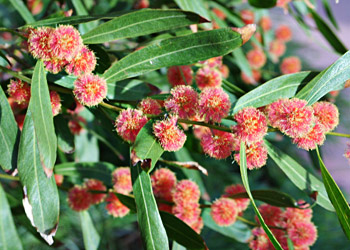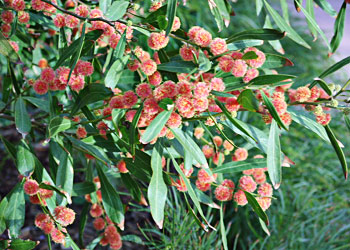
Acacia leprosa and 'Scarlet Blaze'
Esther Brueggemeier
Acacia leprosa, Cinnamon Wattle, is a beautiful plant that has also been the subject of some confusion and controversy. First of all it is called the Cinnamon Wattle because the leaves, not flowers, release a beautiful cinnamon-like fragrance especially in hot weather. It is regarded as a particularly hardy large shrub or small tree tolerating frost to -7 degrees C and can be cultivated throughout much of Australia. The Cinnamon Wattle is naturally found scattered down through eastern Australia.
Four main variants are recognised.
| Variant |
Population |
| 1. Typical variant |
Appears to be uncommon and scattered.
North of Monto Queensland.
Near Mittagong and Mt Werong New South Wales.
Warri Yallock, Marysville and Orbost, Victoria. |
| 2. Dandenong variant |
Locally common in Victoria.
Dandenong Ranges and western foothills from Ringwood to Woori Yallock and south to Dandenong township, also occurrences at Myrniong Ck.
A specimen from the Grampians is possibly also this variant. |
| 3. Seymour variant |
Appears to be rare.
Restricted to the vicinity of Seymour on the Goulburn River, Victoria. |
| 4. Large phyllode variant |
Scattered in Victoria.
Trentham east to Buxton and Orbost, with a single occurrence at Mt Tayar, New South Wales. |
Acacia leprosa is mostly confused with Acacia verniciflua (Varnish Wattle). Generally, one distinguishing factor was how many main nerves were found per phyllode. (A. leprosa 1-nerved, A. verniciflua 2-nerved). Recent studies, though, have shown that this is not the most useful character for classification as both species were found to have one-nerved, two nerved or both within a single plant! Therefore, studies are continuing and we will try to keep you up to date.
Acacia leprosa 'Scarlet Blaze'
History and Discovery
In 1995 a group of bushwalkers calling themselves 'Warrandyte Wanderers' were on a track near the Wilhelmina Falls in the Black Range State Forest north-east of Melbourne. On a small side track one of them noted a single red-flowering specimen of the distinctive large phyllode variant of Acacia leprosa, Cinnamon Wattle, amongst the usually yellow-flowering ones.
 |
|
Acacia leprosa 'Scarlet Blaze'
Photo: Tony and Brenda Moore
|
|
Not really understanding the full significance of what they had discovered, one of the ladies picked a piece and took it for identification. She passed it on to someone with an interest in Australian plants who was eventually persuaded to pass the specimen on to the National Herbarium of Victoria at the Royal Botanic Gardens in South Yarra.
Bill Molyneux, co-owner with Sue Forrester of Austraflora, was phoned and asked if he knew of an intense red-flowering wattle. He went in to have a look and confirmed that it was Acacia leprosa, incredibly with red flowers.
Because the original discoverer wasn't readily contactable, it was difficult to determine where the plant had been collected. Bill therefore contacted David Cameron, a botanist then working at the Warrandyte State Park Office. Since David's role includes the assessment of conservation status of the Victorian flora, Bill felt that David's involvement was particularly relevant.
David knew one of the members of the bushwalking group who agreed to take the two to the site in the company of the local ranger. At the same time, because this plant was so rare, David decided that it should be propagated as a matter of urgency and for Bill Molyneux to take a small number of cuttings to be passed on to the Royal Botanic Gardens nursery and, as a backup, possibly one other propagator.
When the four of them arrived at the location they were stunned to find that the plant had been all but stripped! Evidently someone who knew where it was, had been there recently and taken most of the available cutting material. Therefore the original plant that the bushwalker reported as almost "8 feet high and spreading" was now a twiggy skeleton less than 6 feet high and 2 feet across. David decided that they should take a small number of whatever cuttings remained in an attempt to rescue the plant from oblivion. (When I confirmed these details with David, that the plant had been severely cut back before they saw it, I couldn't help but notice the frustration and abhorrence in David's voice to the raping of the plant.)
Since it was highly unlikely that this plant would have survived following such an ordeal, 12 cuttings were taken on that day, six of which went to the Royal Botanic Gardens nursery and six to the Carawah Nursery in Hoddles Creek. From these original 12 cuttings, only 3 tubes survived and these were all then held at the Royal Botanic Gardens so they could eventually be potted on. These three little tubes became the foundation for all the stock we now have. Therefore it can truly be said that the rescue operation was a success!
Sadly, but not unexpectedly, a short time later the ranger reported that the original plant had died. It later transpired that the excessive number of cuttings taken illegally apparently all failed to strike.
Through my conversation with Bill it became evident that stories currently circulating regarding the discovery and propagation of the Red Wattle quite misrepresent the truth. Bill said that he has heard rumours that it was supposedly Bill himself who raided the plant and killed it! Nothing could be further from the truth. Bill was, in fact, instrumental in the rescue operation. It is indeed a sad reflection on the rumour mill that such misrepresentation of the truth could develop.
| |
 |
|
Acacia leprosa 'Scarlet Blaze'
Photo: Esther Brueggemeier
|
Bill was subsequently engaged by the Royal Botanic Gardens as a qualified person for Breeders' Rights to undertake the assessment of the Red Wattle's eligibility for protection under plant breeders' rights. The Red Wattle's eligibility was confirmed and it was therefore promptly registered. It was also during this process that Bill was asked whether Austraflora should be one of the companies to be considered for commercialisation of the Red Wattle. Because of the possibility of a potential conflict of interest, Bill declined and instead became involved in the selection of an appropriate nursery to undertake commercial propagation of the Red Wattle.
Cultivation Notes
Since the successful launch onto the horticultural market the Red Wattle has turned out to be quite drought tolerant, requiring only occasional deep watering once established. It is relatively easy to grow as long as it doesn't get over-watered, which we have a tendency to do with rare plants. The Red Wattle also prefers a well-drained, moist soil in full sun to dappled shade. From personal experience, the ones planted in full sun grew faster and flowering was delightfully abundant.
This plant is rather versatile too, being used well as a soft screen or a specimen. If anyone has a hankering towards Japanese-style gardens, then this is the perfect soft tree for you because of its gentle weeping habit, as shown in the photo below. A light trimming immediately after flowering will encourage beautiful new growth.
 |
|
Acacia leprosa 'Scarlet Blaze' - Gentle weeping habit
Photo: Esther Brueggemeier
|
|
Now and the Future
This amazing discovery and rescue should prompt us to think seriously about certain issues. Without the diversity of our flora and fauna the environment cannot survive and we may have nothing left to pass on to our children. Big and fast money certainly cannot bring true happiness. I, personally, have planted many Red Wattles (amongst others) for nothing. Yes, the true profits came when I saw these amazing plants thriving and flowering whilst attracting all the birds and insects that you can imagine. This area has become a beautiful haven for them. I really don't want to sound like a sales-person, but surely we can do our part for the environment and look at planting some rare flora in our own garden.
For those of you who used to be regular customers at Austraflora, whilst it ran as a major wholesale/retail nursery in Montrose for many decades, you may be wondering what they are doing now. Well, here's a yummy smackerel of information for you!
Bill Molyneux and Sue Forrester now operate from a home-based office in the heart of the Yarra Valley at a beautiful place called Dixons Creek. Whilst very busy sourcing, developing and licensing new varieties of native plants Australia-wide, they are also active in environmental issues and botanical research. I'm also the lucky duck who knows that they are about to name three new wattle species of ancient alpine origin from Gippsland. There is a paper on them which will be published in Muelleria, the house journal of the National Herbarium of Victoria, very soon.
An extra bonus is their beautiful bed and breakfast cottage which I can vouch for - see details on their website. My husband and I spent a weekend there and came back relaxed and revived. Definitely worth visiting so put it on your 'Things to do.....' list.
At this point I would also like to thank both Bill Molyneux and David Cameron for their kind support and knowledge in bringing this article together.
From the newsletter of ASGAP's Acacia Study Group, December 2007. Esther Brueggemeier is the leader of that Group.
Australian Plants online - 2008
Association of Societies for Growing Australian Plants
|